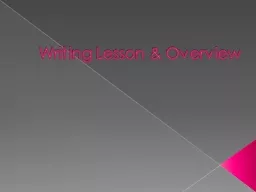PPT-Writing Lesson & Overview
Author : yieldpampers | Published Date : 2020-07-01
The Writing Process Prewriting Brainstorming Drafting Revising and Editing REMEMBER The AIMS writing exam is not a timed test so you should have ample time to go
Presentation Embed Code
Download Presentation
Download Presentation The PPT/PDF document "Writing Lesson & Overview" is the property of its rightful owner. Permission is granted to download and print the materials on this website for personal, non-commercial use only, and to display it on your personal computer provided you do not modify the materials and that you retain all copyright notices contained in the materials. By downloading content from our website, you accept the terms of this agreement.
Writing Lesson & Overview: Transcript
Download Rules Of Document
"Writing Lesson & Overview"The content belongs to its owner. You may download and print it for personal use, without modification, and keep all copyright notices. By downloading, you agree to these terms.
Related Documents


![[EPUB] - The Giant Encyclopedia of Lesson Plans for Children 3 to 6 (GR-18345)](https://thumbs.docslides.com/901211/epub-the-giant-encyclopedia-of-lesson-plans-for-children-3-to-6-gr-18345.jpg)
![[DOWNLOAD] - 180 Days of Writing for Sixth Grade - An Easy-to-Use Sixth Grade Writing](https://thumbs.docslides.com/901243/download-180-days-of-writing-for-sixth-grade-an-easy-to-use-sixth-grade-writing-workbook-to-practice-and-improve-writing-skills.jpg)
![[READ] - The Reading Lesson: Teach Your Child to Read in 20 Easy Lessons (1) (The Reading](https://thumbs.docslides.com/901425/read-the-reading-lesson-teach-your-child-to-read-in-20-easy-lessons-1-the-reading-lesson-series.jpg)
![[DOWNLOAD] - 180 Days of Writing for Third Grade - An Easy-to-Use Third Grade Writing](https://thumbs.docslides.com/901429/download-180-days-of-writing-for-third-grade-an-easy-to-use-third-grade-writing-workbook-to-practice-and-improve-writing-skills.jpg)
![[DOWNLOAD] - 180 Days of Writing for Kindergarten - An Easy-to-Use Kindergarten Writing](https://thumbs.docslides.com/901444/download-180-days-of-writing-for-kindergarten-an-easy-to-use-kindergarten-writing-workbook-to-practice-and-improve-writing-skills.jpg)
![[EBOOK] - Teaching Writing in Kindergarten: A Structured Approach to Daily Writing That](https://thumbs.docslides.com/901683/ebook-teaching-writing-in-kindergarten-a-structured-approach-to-daily-writing-that-helps-every-child-become-a-confident-capabl.jpg)
![[EBOOK] - 180 Days of Writing for First Grade - An Easy-to-Use First Grade Writing Workbook](https://thumbs.docslides.com/901798/ebook-180-days-of-writing-for-first-grade-an-easy-to-use-first-grade-writing-workbook-to-practice-and-improve-writing-skills.jpg)
![[READ] - Writing a Successful College Application Essay (Barron\'s Writing a Successful](https://thumbs.docslides.com/901982/read-writing-a-successful-college-application-essay-barron-s-writing-a-successful-college-application-essay.jpg)
![[DOWNLOAD] - The Creative Writing Student\'s Handbook (Creative Writing Matters Guides)](https://thumbs.docslides.com/905252/download-the-creative-writing-student-s-handbook-creative-writing-matters-guides.jpg)
![[READ] - The Only Writing Series You\'ll Ever Need - Grant Writing: A Complete Resource](https://thumbs.docslides.com/905612/read-the-only-writing-series-you-ll-ever-need-grant-writing-a-complete-resource-for-proposal-writers.jpg)
![[EBOOK] - Teacher Planner: Lesson Planner for Teachers Weekly and Monthly | Academic](https://thumbs.docslides.com/905635/ebook-teacher-planner-lesson-planner-for-teachers-weekly-and-monthly-academic-year-lesson-planner-for-teachers-and-homeschool-61c0085502ac0.jpg)
![[READ] - How Can I Inspire my Painting Class? (Black and White Edition): Lesson Plan](https://thumbs.docslides.com/906766/read-how-can-i-inspire-my-painting-class-black-and-white-edition-lesson-plan-ideas-for-oil-painting-in-post-compulsory-educ.jpg)
